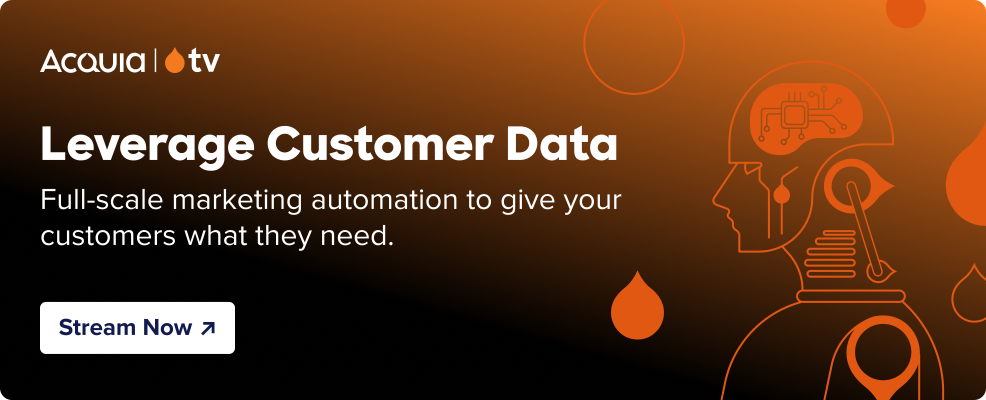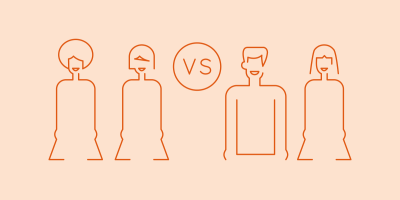
Customer Segments vs. Personas: What's the Difference?

Successful marketing often lies in balancing customers as both human beings and data points. Meaningful marketing hinges on reaching the emotions of human beings through the lens of a data trail. When you synthesize the two — emotions and data — you can better predict what people are looking for, serve what they want, and create an enjoyable customer experience (CX).
Marketers use both customer segments and customer personas to attract like-minded audiences, but the two aren’t the same: Segments are groupings of customers you’ve already acquired, while personas are characters based on customer clumps that you may already have but want to attract more of.
Segments help forecast market interest in a product or service based on existing customer data, while personas help teams understand the emotional and behavioral triggers behind the individuals that make up those data segments. Segments and personas act as powerful, complementary marketing tools for more in-depth and accurate customer targeting.
But, before you develop your strategy for using them, let’s take a look at important distinctions between the two.
What is a customer segment?
A customer segment is a group derived from a large body of data and who share characteristics. Put another way, it’s looking at current customer data and choosing specific, shared criteria to target — all women between the ages of 45 and 55 in south Florida who bought flip flops from your brand in the last 6 months, for example. (And no, segments aren’t the same as clusters.)
Types of customer segments
Given the amount of customer data organizations ingest (and the chaos that it can cause), the types of customer segments you could have is vast. For now, let’s look at common segments.
- Geographic: Where are your customers located? This category can be as broad or as narrow as you want depending on your organization's geographic targeting goals, reach, where its stores or offices are located, etc.
- Psychographic: This category captures your customers’ personalities. It involves more detailed, qualitative information you might glean from surveys, reviews, etc.
- Demographic: Here, you have common statistical information, such as age, gender, profession, race, income level, and the like.
- Behavioral: This category taps into what your customers do. How do they use your website? What common or repeated patterns do they follow? Have they clicked on something 10 times but not bought it yet?
- Technographic: There are tons of different devices, browsers, and digital platforms that people operate. How do customers access your products?
- Needs-based: These are the must-have check boxes. Many customers shop for items with certain features and capabilities, and brands survey prospects to determine what those are. Respondents are typically forthcoming with their answers. You can then separate people into groups based on the must-haves they identified in the survey.
- Value-based: What do people get out of your product? These customers prioritize ROI and want to see tangible, economic value from your product. This segment is more common in the B2B world.
Naturally, some customer segments are easier to identify than others. Form data and behavioral data, for example, require different levels of work and acquisition methods. Nailing some segments down will help before moving onto putting a face — the persona — to those groups.
What is a customer persona?
A customer persona is a partially fictional character meant to mirror the shared characteristics from data collected in a customer segment — an ideal customer, in other words. Researching real people leads marketers to put together a profile of interested “customers,” including giving them names and describing their hobbies, preferences, and motivations — as many details to round them out for sellers, marketers, or anyone with a customer-facing role. Then, teams can personalize experiences to that persona in hopes of attracting real customers who match. Basically, personas add emotional and behavioral components to a segment.
Building a customer persona
Because human beings are diverse and their desires and behaviors constantly change, the number of personas you could come up with may be huge. Knowing your industry and organizational goals will help you narrow that down, as well as help you build and target the personas you aim to attract.
So, let’s create a customer persona for a boutique — let’s call it Dolce & Banana — that sells high-end little black dresses (LBDs). The company panders to high-fashion houses, designers, and metropolitan socialites with cash to spare. When people buy dresses they like, it’s common for them to come back for more, like this person:
Name: Miranda Priestly, CEO
Bio: Miranda is a successful executive at an influential fashion magazine. Her personal brand is something tabloids pay attention to just as closely as they focus on her influence over the brand she heads up. She wants to stay ahead of trends in the fashion industry and look the part of an effortlessly fashionable icon.
Demographics:
- Gender: Female
- Age: 50
- Location: New York City
- Education: Master’s degree
- Job title: CEO
- Income: $400,000+
Struggles that Dolce & Banana can address for Miranda:
- Needs: Continued credibility across the fashion world without trying hard
- Motivations: Wants to keep personal style and brand influence on par or ahead of other fashion publications. Having the most fashion-forward LBDs at public events would help boost that image.
- Pain points: There are a lot of fashion lines out there, and she doesn’t have time to sift through them all. A timelessly elegant piece like the LBD is a perfect option.
- Persona journey: Miranda’s magazine has recently featured Dolce & Banana’s LBDs. Her driver takes her to your boutique to see them in person. Your knowledgeable, well-heeled stylists offer her champagne while she tries something on. Special treatment and bespoke tailored offerings go a long way with her.
Making personas can be a lot of fun (as you might’ve noticed), and they carry an important function in humanizing customer segments. Each persona needs customized marketing. They respond to different tactics and make choices for different reasons. Even if your organization's end goal is a sale, the way customers arrive at the sale is rarely the same.
What’s the difference?
Think about the difference between segments and personas as the divide between history and historical fiction. Customer segmentation mirrors history in the sense that it reflects existing data. Personas are made-up profiles based on existing data in hopes of attracting real people similar to that persona.
While segments and personas are both tools for grouping current and potential customers, they provide two separate use cases for businesses. Together, they can paint a comprehensive and complete picture of how a business could market to its customers. And, once a company has grabbed the customers’ attention, segments and personas can tell you how best to target those prospects to relate to their wants and needs.
Segments are primarily used to help determine whether a brand or product is attractive to certain groups in the marketplace. They're great for helping shape a brand’s messaging, content strategy, and product targeting. Segments can be used to initially attract new customers to your brand.
Personas, on the other hand, put a semi-fictional face to that segment. Customer personas allow a brand to have true insights into the psychological and emotional wants and needs of their consumers. By designing personas, brands have a detailed character and associated story they can apply to real-life scenarios and that help them understand the wants and needs of real people.
Personalizing your digital strategy
The marketing adage “content is king” is hollow without personalization. You can make as much content as you want, but unless it’s personalized, it’s less likely to help your organization achieve its goals. In fact, 71% of consumers reported that they expect personalized experiences, and 76% are frustrated when they don’t get it, according to McKinsey.
Customer segments and personas are foundational to personalization. Once you’ve done the work of digging into your customer data and can paint a picture of who’s buying your product and who might be interested in buying it down the road, you can better produce content that draws people in.
The thing that segments and personas do share is a human end-game: getting to know actual people and giving them relevant information that helps them solve a problem. You can’t do that without personalizing your digital strategy. The first step to achieving that effectively is by collecting, organizing, and strategizing with customer data.
What’s next?
The whole point of highlighting the differences between customer segment and personas has been to magnify the importance of organized customer data. When you can better parse customer data and quickly put together segments and personas, you can more quickly iterate on targeted marketing efforts tailored to those groups. That can be tough to do without some help keeping your customer data together, which is exactly what a customer data platform (CDP) does.
Ready to see your customer data prepped for action? We’d love to show you how Acquia CDP can set you up for customer data success.



